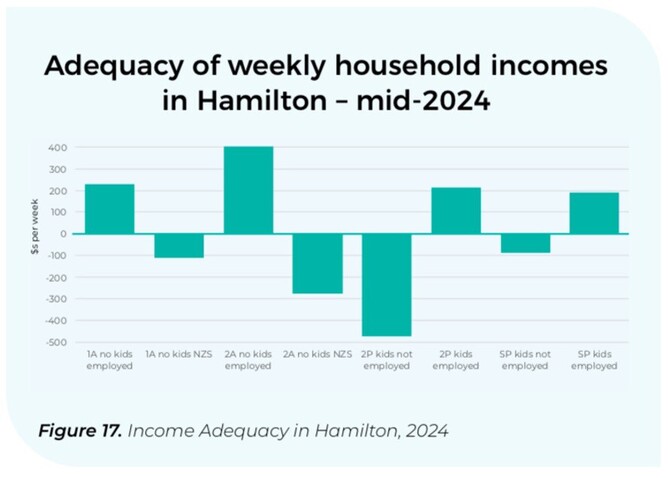Hamilton City Councillor and SDG 1/2 Manu Taki, Dr. Anna Casey- Cox shares her thoughts about the importance of affordable rents- not only in terms of the need for safe and secure homes, but also the relationship between housing and kai security- which was highlighted by the WWP’s 2024 report Want Amongst Plenty. For more information contact Anna at Anna.Casey-Cox@council.hcc.govt.nz
The Waikato Housing Initiative’s latest Housing Stocktake reveals a shortfall of 3,240 homes in Kirikiriroa (Hamilton) in 2023. To meet the projected housing demand over the next two decades (25,892 homes), approximately 1,300 homes need to be built each year. However, with declining rates of consenting (1,231 dwellings consented in 2023, dropping to 908 in 2024), and projections over the next three years remaining below the target of 1300, meeting both current and future housing needs is becoming increasingly unlikely.
Additionally, it is essential that the housing being built adequately addresses the diverse needs of our population. Although the WHI Stocktake highlights the construction of 20,000 new homes in the Waikato Region between 2018 and 2023—an impressive feat considering the challenges posed by COVID and other factors—affordability and building homes in the areas of greatest need remain significant hurdles.
Recent data from the Ministry of Social Development reveals that 1,107 people and families are currently on the public housing waitlist for Hamilton City. This includes:
Priority A applicant: Households with severe and persistent housing needs that must be addressed immediately.
Priority B applicants: Households with significant and persistent housing needs.
The public housing waitlist serves, to some extent, as a measure of the private rental market’s effectiveness in meeting demand and addressing unmet housing needs. A breakdown of the waitlist by house size shows that more than half of the demand (597 households) is for single-bedroom homes or units.
The need for single-bedroom accommodation is further supported by the increasing demand for services from Te Whare Korowai Taangata o Kirikiriroa, an emergency housing service for adults. In 2020, it accommodated 108 people (10,809 bed nights), and by 2024, this had risen to 436 people (26,707 bed nights). On average, emergency housing beds (27) are occupied for 40 nights, and transitional housing beds (54) for 247 nights.
While data on the build rate of different-sized homes in Hamilton is difficult to determine, as consent data often lacks specific bedroom numbers, the Council’s Economic Development team has estimated that for every 100 homes built since 2019, the breakdown was as follows:
4 one-bedroom homes
36 two-bedroom homes
14 three-bedroom homes
14 four-bedroom homes
3 five-bedroom or larger homes.
This distribution indicates that the build rate for one-bedroom homes may be inadequate for the existing demand. Age Concern has also raised concerns about the lack of affordable accommodation options for older residents in Hamilton. With the proportion of older renters on the rise, the need for affordable and accessible housing will only grow, increasing demand for one-bedroom homes. Currently, there is no clear strategy or plan to address the housing needs of the growing older population in Kirikiriroa.
Barriers to building affordable one-bedroom rentals stem largely from financing challenges. The cost per square meter for a one-bedroom home is often higher than for larger homes. Additionally, many individuals in need of one-bedroom housing may have more complex and higher needs, along with fixed incomes, making it harder for the market to meet their needs and make a profit.
The latest report from the Waikato Wellbeing Project assesses the adequacy of income for renting households in Hamilton after covering basic living costs (e.g., rent, food, power). The households most likely to experience an income deficit or inadequacy week to week are:
Households primarily reliant on New Zealand Superannuation
Unemployed couples with children
Unemployed Single adults with children
Building and enabling affordable rental accommodation in our communities is vital. At present, the Affordable Housing Working Group is unaware of any plans to build affordable rental homes—including one-bedroom units—at the scale required to meet ongoing demand in Kirikiriroa. The planned build-to-rent development on Cussen St, by Homes by Bakery, may be an example of a development that delivers affordable one-bedroom rentals at some scale (47 one bedroom/studio are proposed).
However, ongoing housing subsidy will likely be required, and it is unlikely that older renters will be able to find adequate and suitable housing without it being provided as social housing. The challenge of building affordable homes is being discussed by the Waikato Housing Initiative, the Waikato Wellbeing Project, Age Concern, and other stakeholders.
References



